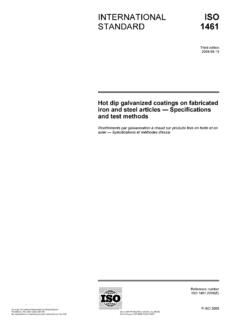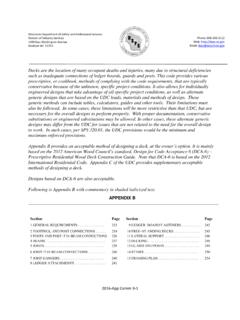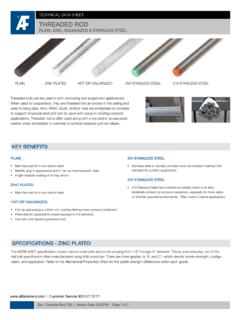Transcription of LTA PADEL COURT DATA SHEET
1 08 Fall LTA PADEL COURT DATA SHEET LTA PADEL COURT DATASHEET GENERAL This data SHEET has been produced in order to provide information and guidance for venues considering the construction of a PADEL COURT . DEFINITION A PADEL COURT is defined as area 20m long x 10m wide enclosed above ground with a combination of glass and weld mesh rebound wall and fence panels supported of steel posts fixed to a concrete foundation with a synthetic turf play surface. PLANNING CONSENT The construction of a PADEL COURT whether totally new on a green field site or over an existing tennis COURT constitutes development and therefore requires formal planning consent to be issued by the relevant Local Authority. All new glass wall or mesh fencing and in height requires planning consent together with any proposed floodlighting posts and fittings. The site developer will be responsible for obtaining planning consent and this will be excluded from most contractors quotations.
2 Careful consideration of the location of proposed PADEL courts should be given in relation to the impact of noise on adjacent residential properties. KEY DIMENSIONS The PADEL COURT internal playing area is 20m x 10m wide and is marked with two service lines and a centre line that crosses over the service line by 10cm as indicated on the right left hand diagram The out of COURT area is indicated on the diagram. The clear unobstructed height above the playing area is a minimum of in order to accommodate floodlights attached to the structure, with a recommendation of for new build facilities. For out-of- COURT play each side of the COURT must have 2 central access points (one to each side). There may not be any obstacles outside the COURT within an area of no less than 2 metres wide ( for competition purposes) and 4 metres long on either side of the COURT and a minimum of metres high SURROUNDING ENCLOSURE AND REBOUND WALLS All PADEL courts have the requirement for the inclusion of rebound ends (with fencing above).
3 At the ends of the COURT a total height of metres is required. The first , from playing surface level, can comprise any transparent or solid material (glass , bricks, etc.) which does not affect ball bounce, and the upper is metal fence (metal weld mesh). The transition between adjacent mesh and glass internal surfaces should be flush and neither surface should protrude further than the other as irregular ball rebound will result. In the most PADEL COURT ends comprise toughened glass rebound panels with a weld mesh section over but could comprise other materials such as rendered blockwork for the first There are two variations of PADEL side walls as identified by the International PADEL Federation (IFP) described as Variant 1 and Variant 2. The difference between the two variants are the overall height of the surround fence / rebound walls with all the fencing/ rebound walls to Variant 2 being high.
4 IFP Regulation allows two variations on the lateral/side enclosures: Variant 1 The majority COURT of installation within the UK Made up of stepped wall areas at both ends, the first step 3m high x 2m long and the second step 2 m high x 2 m long. Areas of metallic fencing complete the enclosure of up to 3 metres in the centre 16 m and up to 4 metres at both ends. A crystal COURT variant allows side glass walls to be 3m high for 4m returns. Variant 2 Is the same as variant 1 but with a 4m overall height. In the UK the majority of PADEL courts constructed to date are Variant 1 using a combination of glass rebound and metal weld mesh panels. The diagram below illustrates the difference between the 2 systems. Glass rebound panels may comprise either 10mm or 12mm toughened glass. 12mm glass provides a more solid structure and is preferred by players for superior rebound characteristics and should be a minimum specification for UK installations.
5 Glass rebound panels shall incorporate counter sunk fixings to avoid affecting ball bounce and all shall be individually kite marked to the European Standard. Consideration should be given to glass manifestation on the bottom of the COURT and at a height of between 850mm and 1000mm for health and safety. If further information is required then please refer to Part K of the building regulations. Glass and weld mesh panels are supported by steel posts or framed steel panels with base plates for fixing to the concrete ring beam. Toughened (or tempered) glass panels are used as the glass is specially treated so it will break into small blunt pieces under pressure making it much safer than shards of normal glass. The above photograph indicates a panoramic PADEL COURT with framed end wall with no intermediate supporting steel posts. The weld mesh sections of the surround walls should be made up of rhomboids or squares simply twisted or soldered with voids (diagonally measured) no less than 5 cm and no larger than cm.
6 Recommended thickness of the steel wire is between mm and 3 mm. With a maximum of 4 mm and a tension which allows the ball to bounce off it. The outward facing mesh must be horizontal. The side elevations will incorporate a central opening for player access on one or both sides, or where the out of COURT play area ( x overall) is to be incorporated for higher levels of play. Openings for access may be single or double arrangement. Access opening dimensions must be as follows:- 1) One lateral access per side the opening must be a minimum of x and a maximum of x ; 2) Two lateral accesses per side the openings must be a minimum of x m and a maximum of x m. Provision shall be made for the incorporation of hinged sections of mesh to permit wide sport wheelchairs or wider opening dimensions. SUB-BASE CONSTRUCTION & DRAINAGE In continental Europe PADEL courts are generally constructed with an insitu concrete slab onto which the synthetic turf surface is laid (as the photograph below indicates).
7 This type of concrete slab constructed is generally non porous and would be generally considered un-suitable for the UK climate where high levels of rainfall can be anticipated on a regular basis leading to reduced utilisation. As such in the UK PADEL COURT sub-base construction should comprise a suitable free draining non frost susceptible aggregate sub-base average 250mm depth with 65mm depth of porous asphalt installed above in two separate layers. PADEL COURT sub-base construction can be installed with a maximum single or dual plane gradient of 1:100. Alternatively the PADEL COURT may be constructed to a level gradient with a suitable fall established to the formation level. PADEL courts may also be constructed with a crowned net line with opposing falls of 1:100 to the end walls. But this would not be envisaged with porous sub-base construction.
8 An internal surface water drainpipe should be incorporate with an outfall through the perimeter ring beam to the outfall position. Where constructing a PADEL COURT over an existing tennis COURT , then careful consideration of the existing gradients, surface tolerance of the existing surface and the accurate of position of the new PADEL COURT is required. The upper surface of the ring beam should be established at a level above the highest point of the existing surfacing. As such the installation contractor will have to make any allowance for shuttering of the concrete where higher than the general COURT area. As such a detailed survey of the existing tennis COURT and sub-base construction required prior to proceeding with the project. The finished tolerance of a PADEL COURT synthetic surfacing shall be 6mm under a 3metre straight edge. CONCRETE PERIMETER RING BEAM The supporting posts and/or framed panels are fixed with base plates and holding down bolts to a perimeter reinforced concrete ring beam.
9 The upper surface of the ring beam will finish at the same level as the underlying COURT sub-base construction. Generally installation contractors and manufacturers will propose a rectangular reinforced concrete ring beam of limited dimensions off which to fix the surrounding above ground structure on the basis of reduced cost. Reinforced concrete ring beams of small dimension may be subject to failure at some point in the future due to the overturning force of local wind loads and the alike. The would recommend that in every instance that the reinforced concrete ring beam is designed by a structural engineer (with a suitable cross section profile) with due consideration of the wind loads for the locality of the site and any other relevant loads (spectators). This design must be backed by the structural engineers professional indemnity insurance. The PADEL COURT structure should in turn be designed with suitable reinforcing incorporated to exceed the expected wind load calculated in the ring beam design.
10 The structure should be bolted to the foundation using suitable anchors to fix the structure to the foundation in line with the structural engineer s calculations. If a venue employs a contractor for both design and construction (or where this is implied) then the contractor should also carry their own professional indemnity insurance in relation to the design of the perimeter ring beam. Courts that are secured to a concrete foundation are considered temporary or event courts. These installations should be avoided over winter months and should be checked regularly for movement. These event style courts are unsuitable for permanent outdoor installation. PADEL COURT manufacturer s warranties do not usually cover structural failure of the perimeter enclosure only failure of the individual components in terms of wear and corrosion. The LTA would recommend that a 10 year warranty is established for all installations.






